Understanding Plantar Fasciitis and Its Causes
Before diving into the treatment options for mild plantar fasciitis, it's essential to understand what it is and its underlying causes. Plantar fasciitis is a common foot condition characterized by inflammation of the plantar fascia, a thick band of tissue connecting your heel bone to your toes. This inflammation can lead to heel pain and discomfort, especially when walking or standing for extended periods.
Various factors can contribute to the development of plantar fasciitis, such as age, obesity, foot structure, and activity level. People between the ages of 40 and 60, those who are overweight or have flat feet, and those who participate in high-impact sports are more likely to experience plantar fasciitis. Now that we have a basic understanding of this condition, let's discuss some effective treatment methods for mild plantar fasciitis.
Stretching Exercises for the Foot and Calf Muscles
One of the most effective ways to treat mild plantar fasciitis is to perform stretching exercises targeting the foot and calf muscles. These exercises can help improve flexibility, reduce inflammation, and alleviate pain. A few examples of such stretches include:
- Toe stretches: Sit in a chair with your feet flat on the ground. Reach down and gently pull your big toe back towards your ankle.
- Calf stretches: Stand with your hands against a wall and one foot behind the other. Keep your back leg straight and press your heel into the ground.
- Plantar fascia stretch: Sit on the floor with your legs extended. Loop a towel around your foot and gently pull the towel towards you while keeping your leg straight.
Perform these stretches at least twice a day, holding each stretch for 15 to 30 seconds.
Wearing Supportive Footwear and Orthotics
Another crucial aspect of treating mild plantar fasciitis is wearing supportive footwear and, if necessary, orthotics. Supportive shoes can help distribute your weight evenly across your foot, reducing stress on the plantar fascia. Look for shoes with adequate arch support, a cushioned sole, and a slightly raised heel.
If you're still experiencing discomfort, consider using over-the-counter orthotics or custom-made inserts. These devices can provide additional arch support and cushioning, further alleviating stress on the plantar fascia.
Applying Ice and Heat
Applying ice and heat to the affected area can help reduce inflammation and promote healing. For the first few days after the onset of plantar fasciitis symptoms, apply ice to the heel for 15 to 20 minutes several times a day. This can help decrease inflammation and numb the pain.
After the initial inflammation has subsided, you can alternate between ice and heat therapy. Applying heat can help improve blood flow to the area, promoting healing and reducing stiffness. Use a heating pad or soak your foot in warm water for 15 to 20 minutes, two to three times a day.
Over-the-Counter Pain Relievers
For temporary relief of pain and inflammation associated with mild plantar fasciitis, over-the-counter pain relievers such as ibuprofen, naproxen, or acetaminophen can be helpful. These medications can help reduce pain and inflammation, making it easier to perform daily activities and engage in physical therapy exercises. However, they should not be relied upon as a long-term solution.
Always consult with your doctor before starting any new medication, and be sure to follow the recommended dosage instructions.
Massage and Self-Myofascial Release
Massaging the affected area can help alleviate pain, improve blood flow, and promote healing. Using your hands, a tennis ball, or a foam roller, gently massage the bottom of your foot and your calf muscles, focusing on any areas of tightness or discomfort. This can help release tension in the fascia and surrounding muscles, reducing pain and improving flexibility.
Perform self-massage for 5 to 10 minutes, two to three times a day, or as needed for relief.
Rest and Activity Modification
Allowing your body to rest and recover is crucial when dealing with mild plantar fasciitis. This may involve reducing or temporarily avoiding activities that exacerbate your symptoms, such as running, jumping, or walking on hard surfaces. Instead, opt for low-impact exercises like swimming, cycling, or using an elliptical machine.
Additionally, try to avoid standing for extended periods or walking barefoot on hard surfaces, as this can further strain the plantar fascia.
Maintaining a Healthy Body Weight
Carrying excess body weight can place additional stress on the plantar fascia, increasing the risk of developing plantar fasciitis or worsening existing symptoms. By maintaining a healthy body weight, you can help reduce this stress and promote overall foot health.
Achieving and maintaining a healthy weight involves a combination of a balanced diet and regular physical activity. Consult with your doctor or a registered dietitian for personalized advice on achieving your weight loss goals.

Write a comment